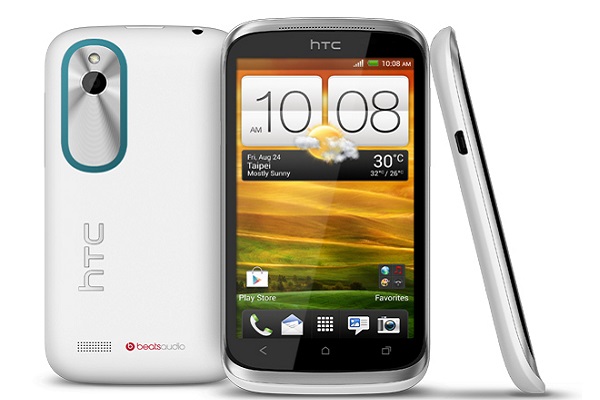HTC Desire X review
Can HTC's latest budget-friendly Android smartphone with its Snapdragon S4 chip, fend off the competition from Motorola's Atom-based Razr i handset?
The Desire X is a well-built handset, but one that has been planned out to a definite budget and not optimised for business use. The low-resolution rear camera and lack of front-facing camera can be overlooked, but its lack of processing power can cause problems for those wishing to run demanding apps, while the buggy operating system is crying out for a patch. For now it might be better to hold off until the bugs are fixed, or look at alternatives such as the flagship Nexus 4, which is dropping with a SIM-free starting price of £239.

HTC, has typically targeted the top end of the market with its Android-based smartphones. Budget-friendly Windows Phone devices like the HTC Radar haven't translated well to the Android ecosystem, and the cheap devices that are available cheaply tend to be have generally been ill-received, such as the high-end Evo 3D model, and quickly reduced in the face of flagging demand.
The HTC Desire family aims to change all that. This latest model, the HTC Desire X, is a compact, curved handset which manages to convey a premium feel in your hand. Based loosely on a scaled-up version of the company's One V, the Desire X packs a lightweight 1GHz dual-core Qualcomm Snapdragon S4 processor, 768MB of RAM and 4GB of internal storage behind a Super LCD four-inch capacitive touch screen.

The curved casing of the device feels comfortable, but the positioning of the power button in the direct centre of the top is awkward and requires you to adjust your grip rather than just reach up with your thumb as with other devices. The rubberised rear is slip-proof, although removal which exposes a micro-SIM slot, micro-SD slot and the battery - is a bit worrying due to the thin plastic used.
Performance
It's immediately obvious from the specification that HTC has cut corners: the memory is down by a quarter compared to the far more common 1GB found on Android smartphones, and, while the processors is a dual-core model, its 1GHz clock speed raises concerns about overall performance.
While it's true that the Desire X fairs poorly in benchmarks (scoring roughly half that of the 2GHz single-core Atom found in the admittedly more expensive Motorola Razr i in synthetic benchmarks), that thankfully doesn't translate into a poor user experience. The user interface, HTC's own Sense 4.0 which sits on top of the Android 'Ice Cream Sandwich' 4.0.4 operating system, is quick to responds to touch and applications open with a minimum of waiting.
Where the Desire X falls down is in 3D performance. The Adreno 203 graphics processor built into the Snapdragon S4 system-on-chip processor just isn't designed for rendering detailed content. Simple games such as the eternally popular Angry Birds, aren't a problem, but more complex titles may cause some notable lagging prove a problem.
Unless you're a hardcore gamer, this won't be too much of a concern, though. Even the low system memory didn't cause too many problems unless multiple memory-hungry applications were open simultaneously - and even then the only evidence was a delay in switching between apps.
Get the ITPro daily newsletter
Sign up today and you will receive a free copy of our Future Focus 2025 report - the leading guidance on AI, cybersecurity and other IT challenges as per 700+ senior executives
Gareth Halfacree is an experienced tech journalist and IT professional, and has been writing since 2006. In addition to contributing article for ITPro, Gareth has been featured in publications such as PC Pro, Techmeme, The Register, The MagPi, and Tom’s Hardware.
In addition to his digital articles, Gareth is the author of several best-selling books. These include the Raspberry Pi User Guide, an essential text for those looking to get started with their Raspberry Pi, as well as The Official Raspberry Pi Beginner’s Guide. Gareth also wrote the Official BBC micro:bit User Guide, a comprehensive guide to setting up the pocket-sized computer, learning to code on it, and even creating your own hardware addons.
-
 Westcon-Comstor and Vectra AI launch brace of new channel initiatives
Westcon-Comstor and Vectra AI launch brace of new channel initiativesNews Westcon-Comstor and Vectra AI have announced the launch of two new channel growth initiatives focused on the managed security service provider (MSSP) space and AWS Marketplace.
By Daniel Todd Published
-
 Third time lucky? Microsoft finally begins roll-out of controversial Recall feature
Third time lucky? Microsoft finally begins roll-out of controversial Recall featureNews The Windows Recall feature has been plagued by setbacks and backlash from security professionals
By Emma Woollacott Published
-
 The UK government wants quantum technology out of the lab and in the hands of enterprises
The UK government wants quantum technology out of the lab and in the hands of enterprisesNews The UK government has unveiled plans to invest £121 million in quantum computing projects in an effort to drive real-world applications and adoption rates.
By Emma Woollacott Published